
|
|
Für die deutsche Fassung bitte nach unten scrollen
|
|
|
|
Greeks, Romans and the Queen of Sheba
|
It is one of the major misconceptions of our time to assume that all Greek antiquities originate from today's Greece, all Roman from Italy, and all Egyptian ancient art from Egypt. In antiquity the Mediterranean region was a vibrant, multi-ethnical world full of motion and exchange, which did not face any barriers of national borders. A wonderful example of this mutual cultural diversity is the monumental bronze statuette of an offering bearer. Greco-Roman influence had come to the Arabic peninsula from the 2nd century B.C. through the trade in artworks. The Sabaean elite enthusiastically embraced this artistic movement, imitating and refining it with local adaptions. Our youth therefore wears a Greek headdress, but his vestment is oriental, for sure inspired by the Persians, and the classical posture as an offering bearer is known from Cyprus. An eclectic artwork, enriched by the most diverse cultures from antiquity.
|
|
|
|
Our Highlight of the Month:
|
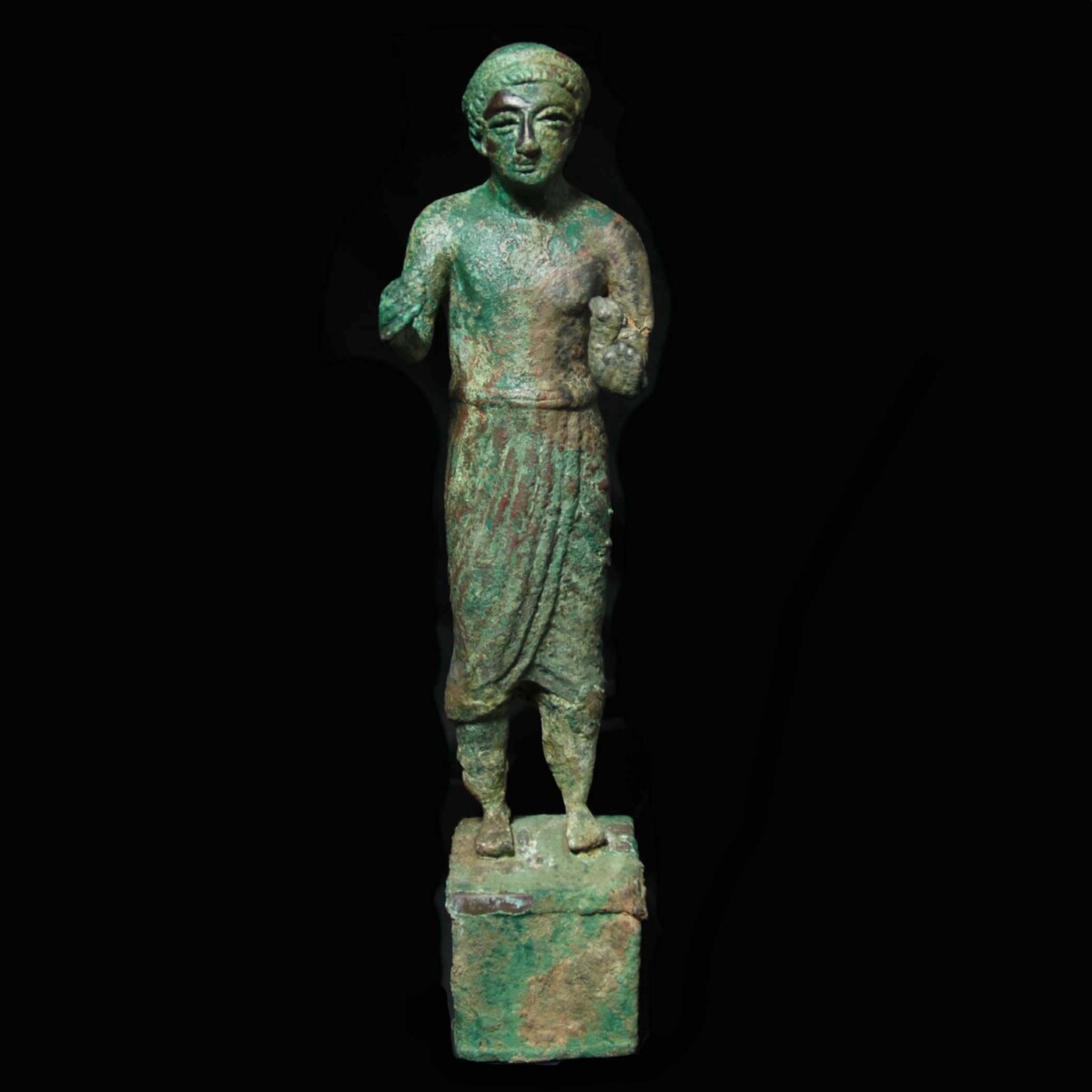
|
|
|
|
|
|
|
|
South Arabia – 2nd-1st century B.C.
|
Large bronze statue of an offering bearer from the South Arabian kingdom of Sheba dating to the Hellenistic period. The young man stands straight with an unclothed upper body. A long, ribbed apron is wrapped around his waist reaching to his knees. Underneath he wears trousers covering his ankles. He has both arms bent and stretched forward. In his left hand he holds a small bird, possibly a rooster. The right hand is raised in a praying gesture. The young man has short hair cascading in broad strands into his forehead and being fixed by a broad filet. The large statue stands on its original base. Votive statues like the present one were found for example in the Awwam temple near Ma’rib in today’s Yemen. See for reference of the hairstyle and the apron the slightly older statue in “Jemen – Kunst und Archäologie im Land der Königin von Saba”, Wilfried Seipel (editor), no. 253, page 327.
|
Provenance: Private collection Shlomo Moussaieff (1925-2015), Israel. Acquired between 1948 and 2000.
Dimensions: 33.5 cm high
Price: 24 000 Euro
|
|
|
|
Selected Artworks of the Month:
|
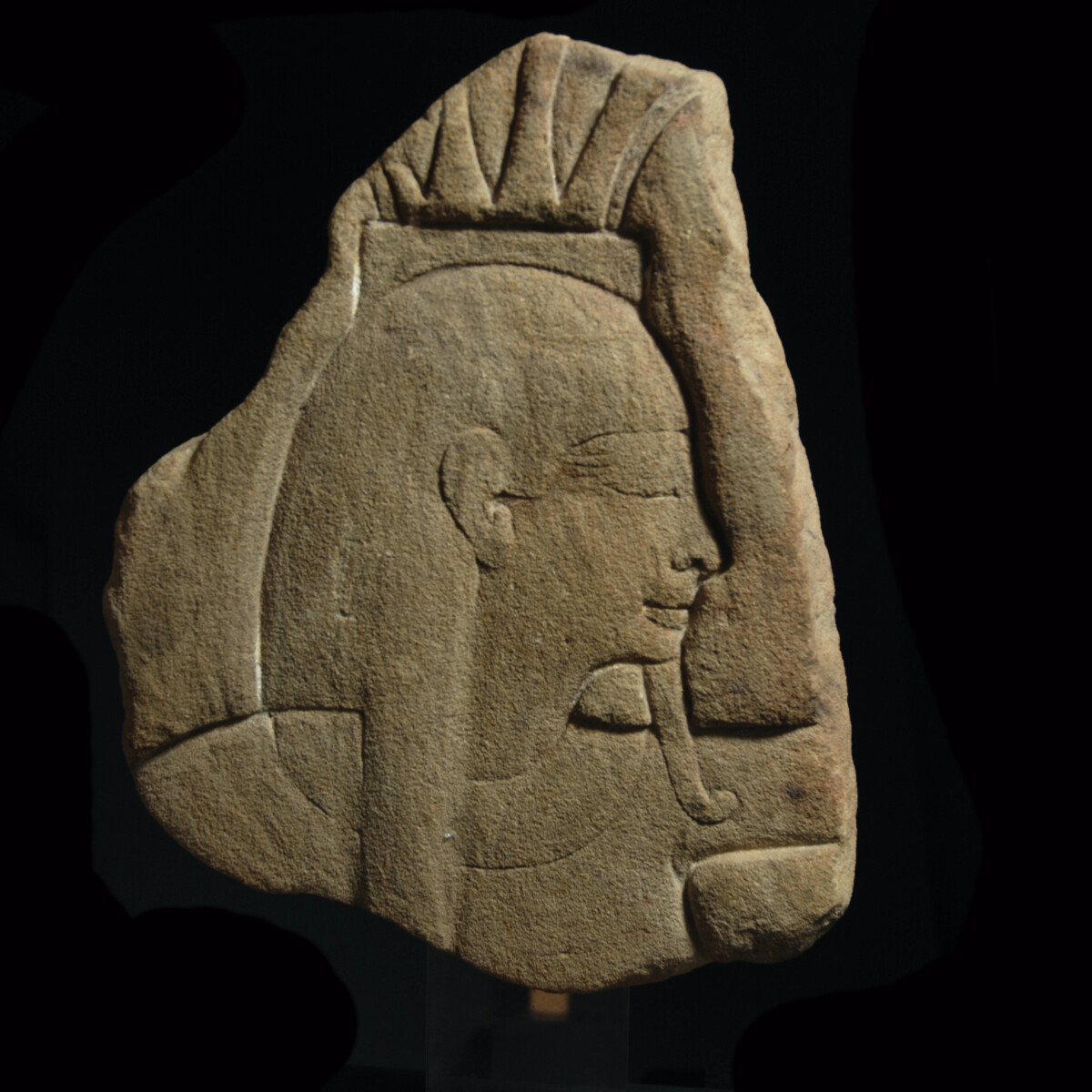
|
|
|
|
Egypt – Late period, 664-332 B.C.
|
Sunken sandstone relief with a finely modelled depiction of Nile god Hapi in profile to the right. Hapi wears a tripartite wig with a long lobe, the false beard, a collar, and a crown with a tuft of papyrus plants. His left arm is stretched forward and holds possibly a papyrus– or lotus stem. Hapi was responsible for the Nile flooding, which left fertile soil behind, and which was called "arrival of Hapi" by the Egyptians. As symbol of the life-giving Nile, he was also worshiped as Creator and "Father of the gods". Mounted.
|
Provenance: French private collection Madame D. for at least 45 years. Last in a court-ordered auction of the private collection of Madame D.
Dimensions: 27 cm x 21.5 cm
Price: 10 000 Euro
|
|
|
|
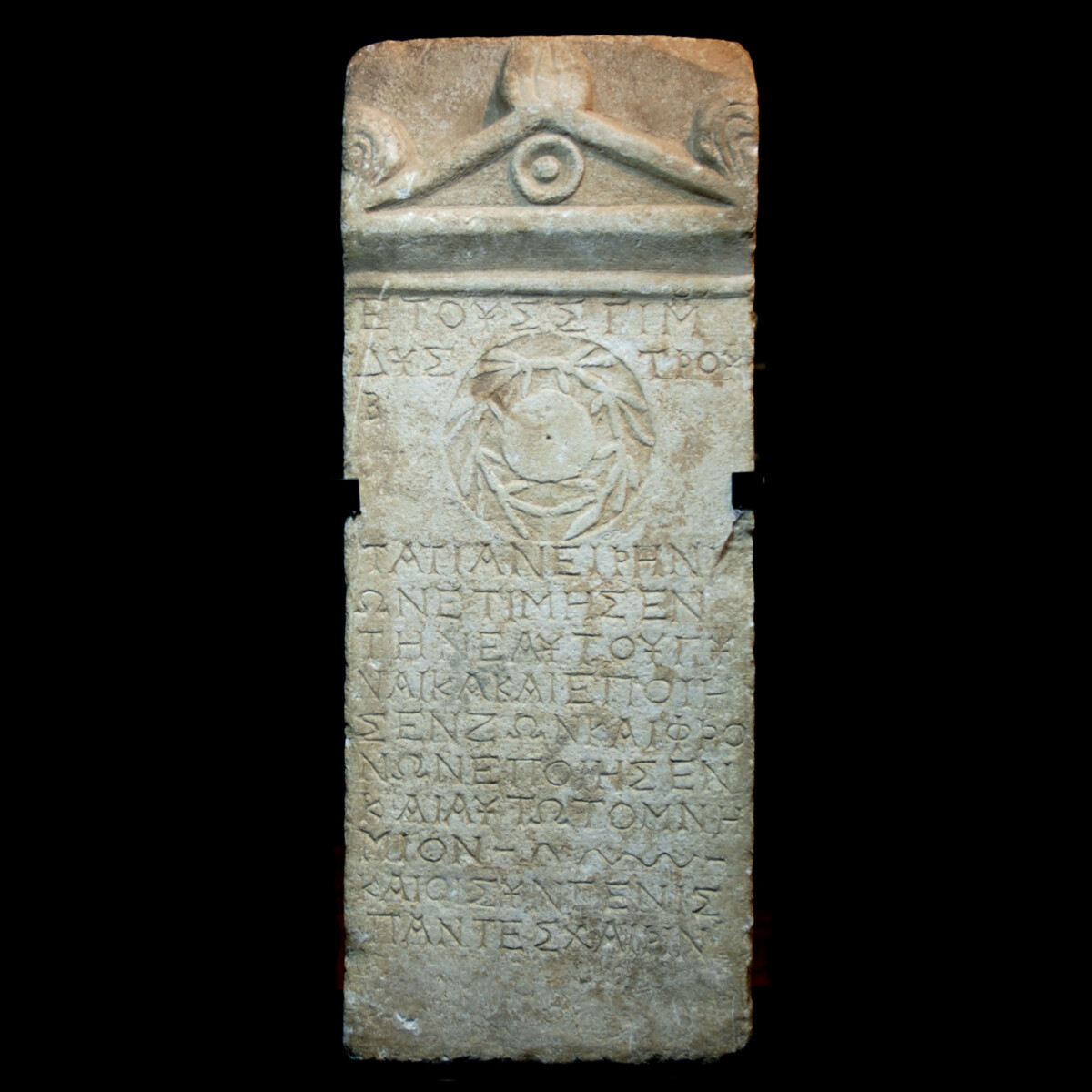
|
|
Roman Empire/Lydia – 129 A.D.
|
Beautifully preserved high rectangular marble stele from Lydia. The stone with a twelve-line inscription is crowned by a gable with acroterion. Right under the gable the dating according to the Sullan era is indicated, i.e., to the year 129 A.D. After that is a leaf wreath. In the following inscription a certain Eirenios honors his late wife Tatia. The translation reads: “Eirenios honors Tatia, his wife and erects during his lifetime and with his full senses also for himself this tomb. And in memory of all relatives.” The text is also a posthumously honorary inscription. See for the type of an inscription stele with leaf wreath the stele for Euarestos from the necropole of Bin Tepe in Sardis, excavated by the Sardis expedition with the inventory number NoEx80.001. With an expertise and translation by the Viennese epigrapher Mag. Katharina Michner BA MA. Mounted.
|
Provenance: German private collection H. W., North Rhine-Westphalia, acquired prior to 1980.
Dimensions: 67 cm x 28 cm
Price: 16 000 Euro
|
|
|
|

|
|
|
|
|
|
Greece/Boeotia – 6th century B.C.
|
Large, hand made plank idol with a flat body, merging into an oval base ring towards the bottom and towards the top to a sculptural head with a face formed from a matrix. The face with archaic features, large eyes framed in black, red cheeks and a broad, smiling, red mouth. Long, black painted hair cascading on the sides to the shoulders. The goddess wears a high, cupped polos with a semi-circular, beak-shaped bulge. The short arms are stretched out sideways and slightly bent forward. On the entire front of the body abundantly preserved painting of red and black lines. On the chest a red hatched area. Red bands around the neck represent jewellery. Idols such as the present one possibly depict goddesses (Demeter, Hera?). Due to the headdress they are also called Papades. Mounted.
|
Provenance: From the old German collection Christian Rolle, with the inventory number 166. Thence with Antikenkabinett Gackstätter with the list number 0991. With the original certificate of the Antikenkabinett Gackstätter. Last in a Munich collection of ancient idols.
Dimensions: 25.6 cm high
Price: 4 800 Euro
|
|
|
|
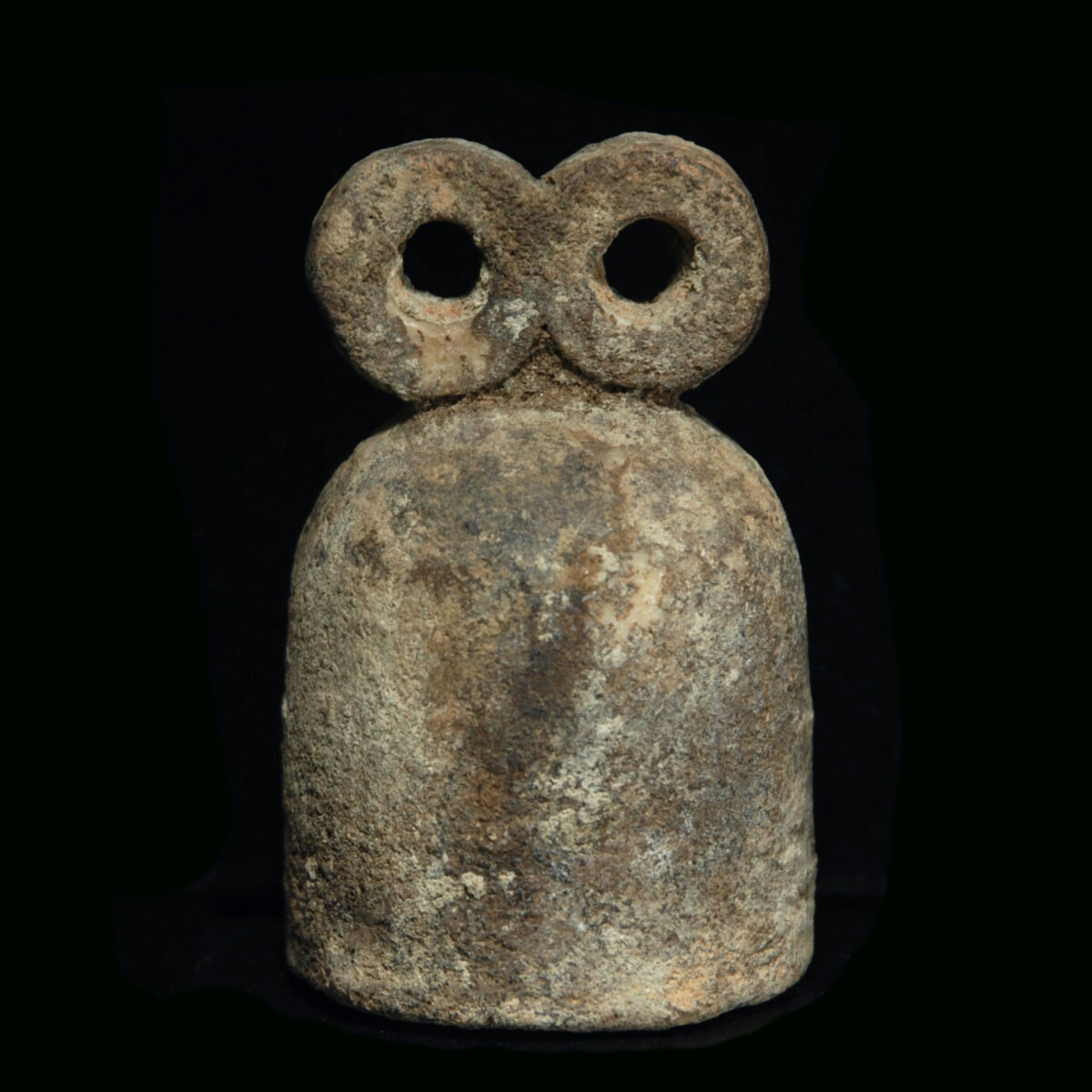
|
|
Mesopotamia – 3500-3000 B.C.
|
Massive, bell-shaped alabaster eye idol. The cylindrical body stands on a flat bottom. The shoulder rounded and tapering to the spectacled worked out pair of eyes. The eyes are circularly pierced. In the area of the neck a notch emphasizes the circular form which increases the effect of the pair of eyes. Idols like the present one were not only found in the famous eye temple of Tell Brak, but also in other places in northern Mesopotamia. This example is supposed to be from Tappa Gaura, a settlement hill in today's Iraq.
|
Provenance: From the old German collection Professor Göring, prior to 1980. Thence with the Antikenkabinett Gackstätter with the list number 01737. Last in a Munich collection. With the original certificate of the Antikenkabinett Gackstätter.
Dimensions: 7 cm high
Price: 4 800 Euro
|
|
|
|
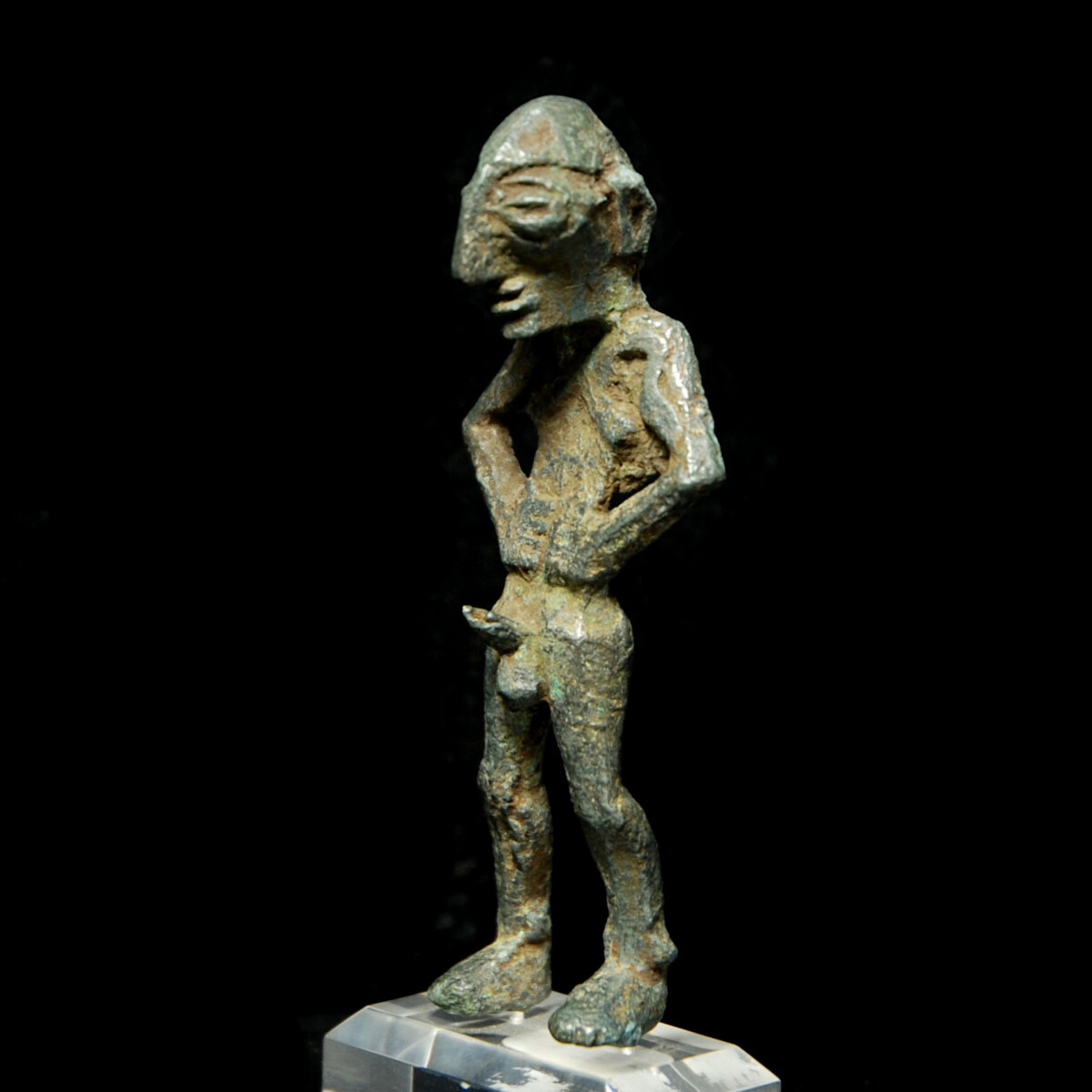
|
|
|
|
|
|
Eurasian Steppe – 8th-6th century B.C.
|
Very expressively modelled ithyphallic idol of the Eurasian nomadic people. The straight standing, very stylised man is without clothes, his legs are slightly apart and his hands are placed on his belly. The flat, almost pressed upper body is slightly bent backwards, exposing the erected phallus. The over-proportional, bald head is completely sculptural. It is dominated by the semi-circular, pointy nose and the bulging eyes. The thin mouth is deeply notched. The legs are accentuated and slightly bent. On the back, from the neck onwards the deep notch of the spine reaching to the buttocks. A rare, highly expressive statuette. Mounted.
|
Provenance: From the old German collection Prof. Levkovic. Thence with Antikenkabinett Gackstätter with the list number 02970. Last in a Munich collection of idols. With the original certificate of Antikenkabinett Gackstätter.
Dimensions: 6.8 cm high
Price: 3 200 Euro
|
|
|
|
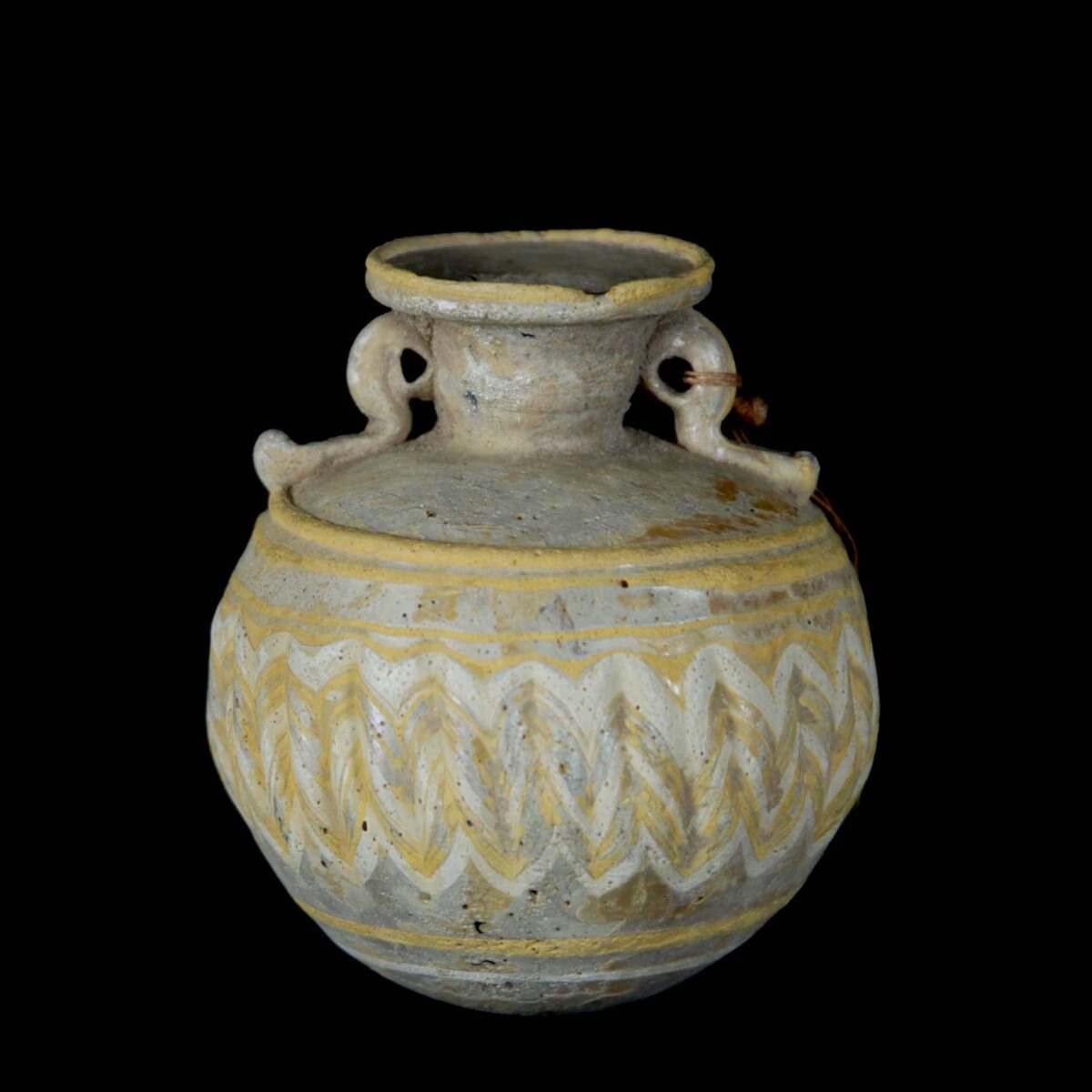
|
|
Greece – 6th-5th century B.C.
|
Opaque, blue glass with a spherical corpus, short neck and funnel-shaped rim. Yellow and white decorative threads are coiled up on the shoulder and on the lower part of the corpus, in between several rows of wavy applied decorative threads. The handles on the shoulder are separately worked out and applied and are called dolphin eyelet handles due to their curved form. On the rim a yellow glass thread. Due to the thick iridescence the aryballos has a wonderfully shimmering mother-of-pearl surface. Aryballoi, formed around a core and once filled with precious essences, were set on a stand. Mounted.
|
Provenance: From the private collection of the French archaeologist Louis-Gabriel Bellon (1819-1899). For over 120 years in the family estate.
Dimensions: 6.5 cm high
Price: 4 600 Euro
|
|
|
|
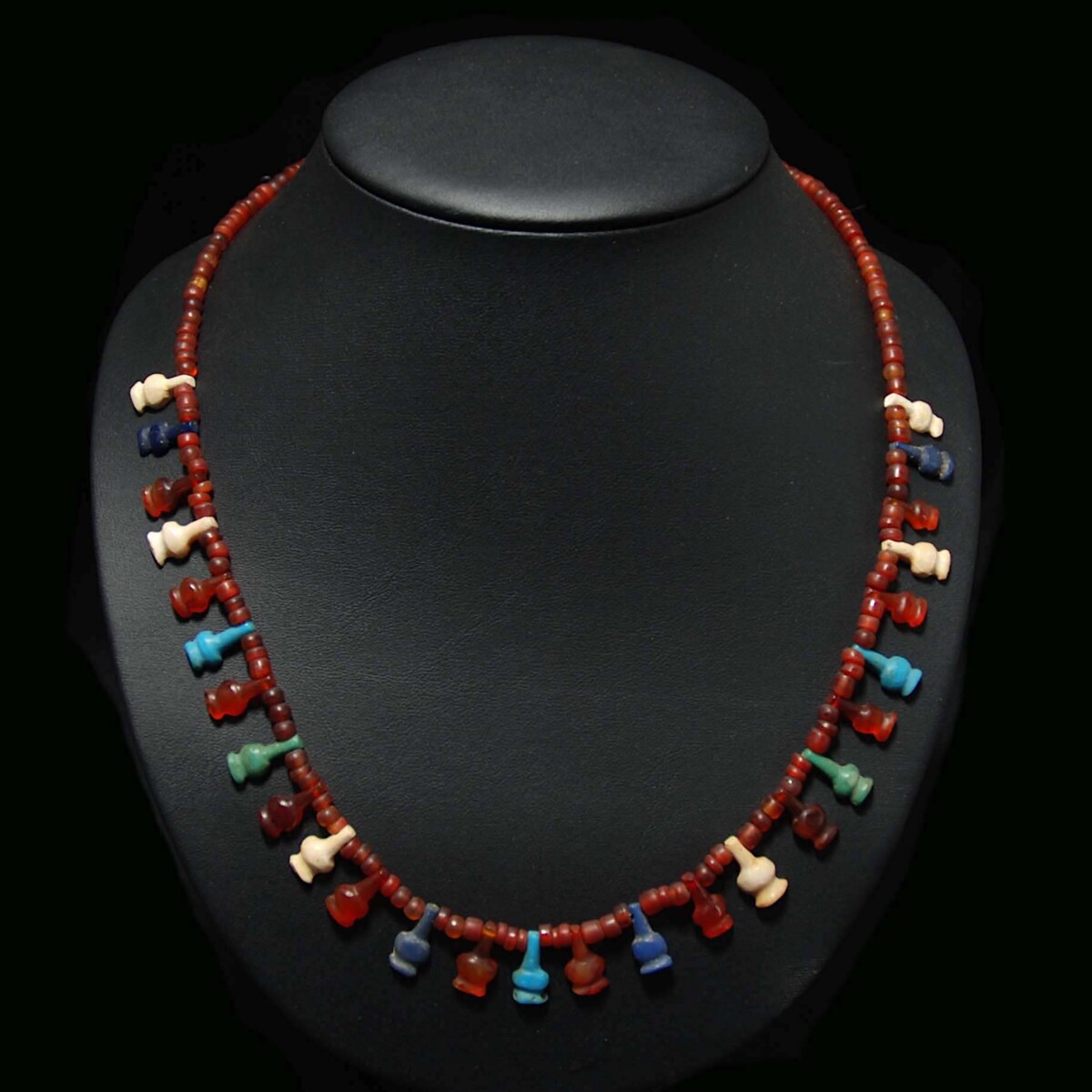
|
|
|
|
Egypt – New Kingdom, 17th-19th dynasty, around 1550-1185 B.C.
|
Magnificent, modern threaded necklace with 27 carnelian and glass poppy flower amulets in red, white, blue and green. In between small carnelian beads. The poppy flower amulets with broad flower heads and open stems for suspension. Poppy flowers were worn in the New Kingdom as regeneration symbols on necklaces, such like in the present one, or individually as an amulet.
|
Provenance: From the old French private collection M. N., acquired in the 1960s.
Dimensions: 53 cm long
Price: 8 000 Euro
|
|
|
|
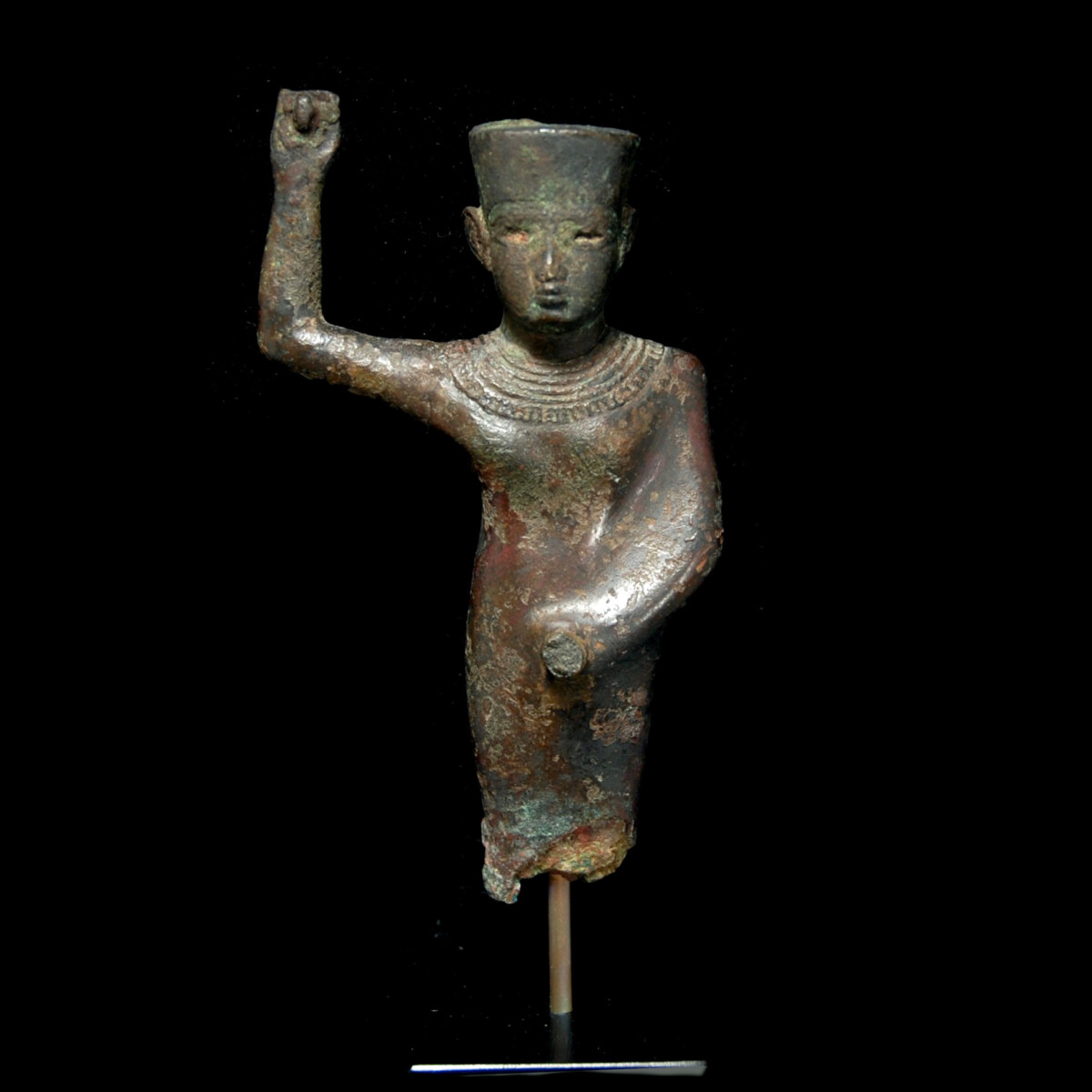
|
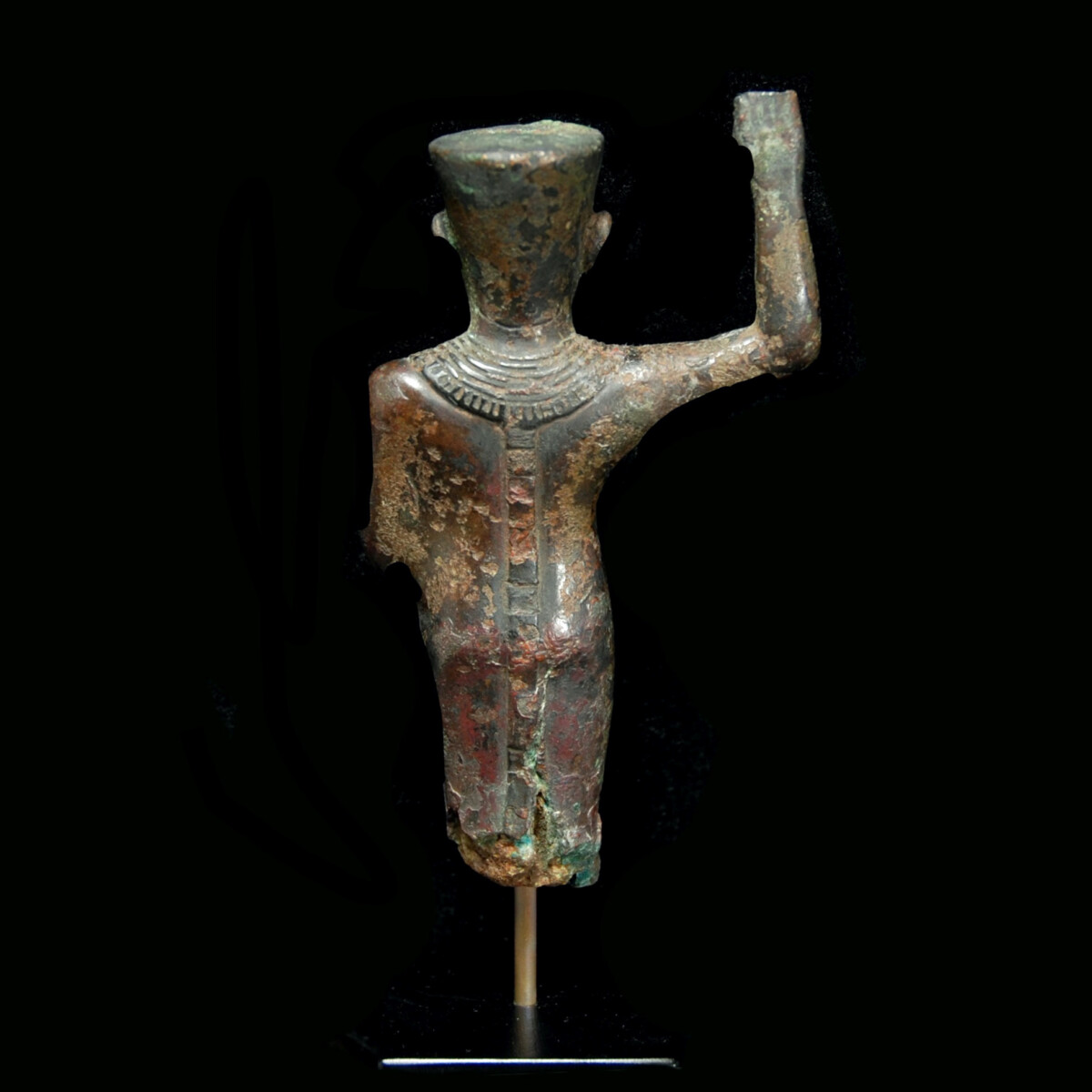
|
|
Egypt – Late period, 664-332 B.C.
|
Only preserved as a fragment, but yet an expressive bronze statuette of the ithyphallic fertility god Min. Min wears a lavish, multilayer necklace, which is in the front and on the back of the same opulence. From the lower end of the necklace runs a vertical decoration band along his back. With his left hand he holds his erected private part, the right arm is raised and bent, Min holds in his hand a flagellum as a symbol of potency. The deeply pierced eyes once held silver inlays. On the head sits a crown with a deep perforation, once with a high pair of feathers, which is also missing. The figure was once of special quality, all attributes were possibly worked out separately. Due to its explicit depiction Min statuettes particularly often fell victim to Early Christian devastation. This also happened to this statuette, where the damages go back to ancient times. See for the type the statuette in the Louvre Museum Paris with the inventory number E 4073. Mounted.
|
Provenance: Collection Gustav Schütz, Vienna, Austria. Acquired between 1920 and 1935. Thence continued to be in the family estate. With a handwritten provenance certificate of the heiress.
Dimensions: 10.6 cm high
Price: 2 200 Euro
|
|
|
|
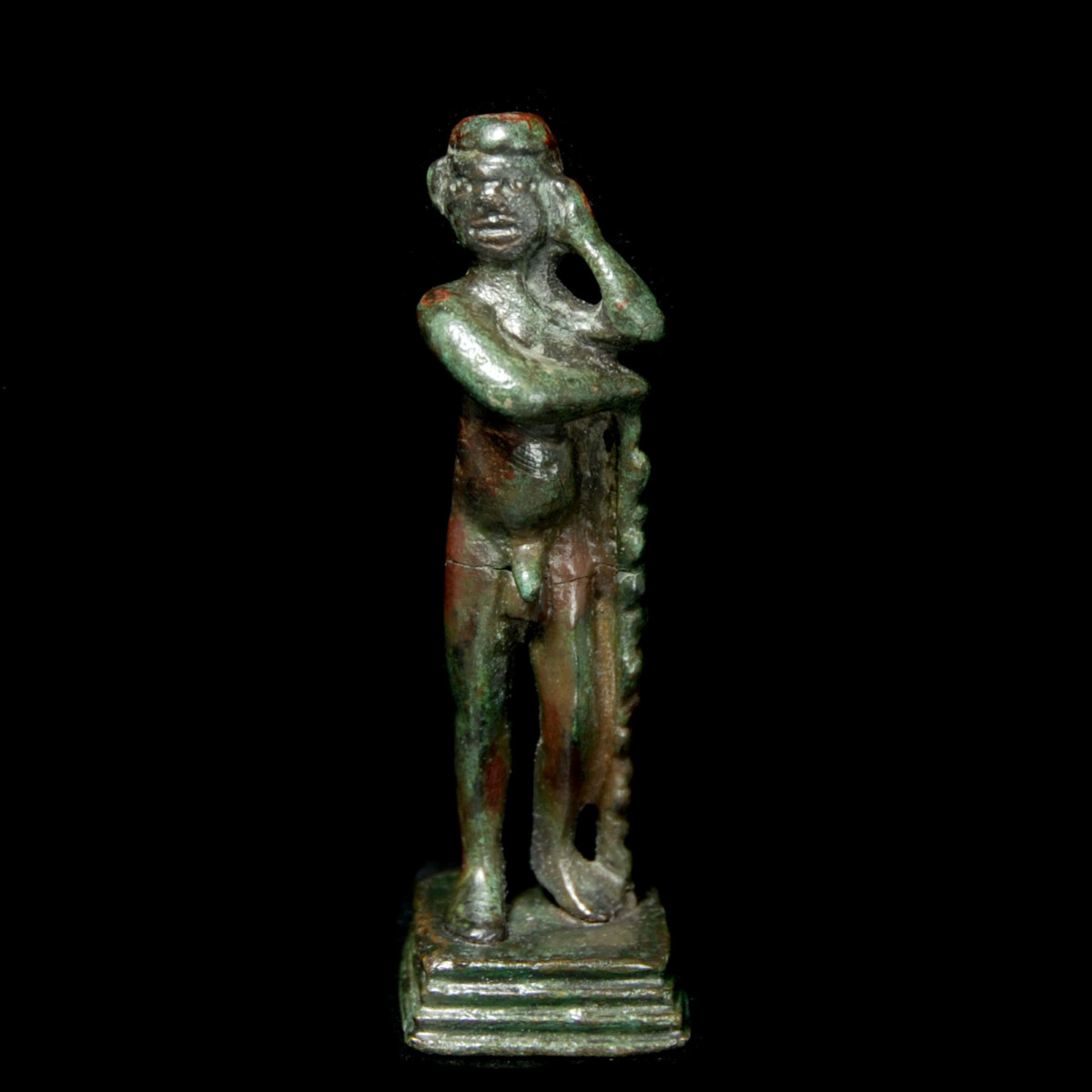
|

|
|
Roman Empire – 2nd century A.D.
|
Finely worked out bronze statuette of an unclothed man with Nubian features. He stands with his weight on his right leg and has his left one slightly bent and tilted outwards. The right hand and the left elbow lean on a long, gnarled staff. The left hand supports the head. The figure stands on its original stepped orginal base. The head is slightly flattened on top, which indicates that the statuette served as a support, possibly for a furniture.
|
Provenance: German collection P. R. since the early 1980s.
Dimensions: 8 cm high
Price: 900 Euro
|
|
|
|
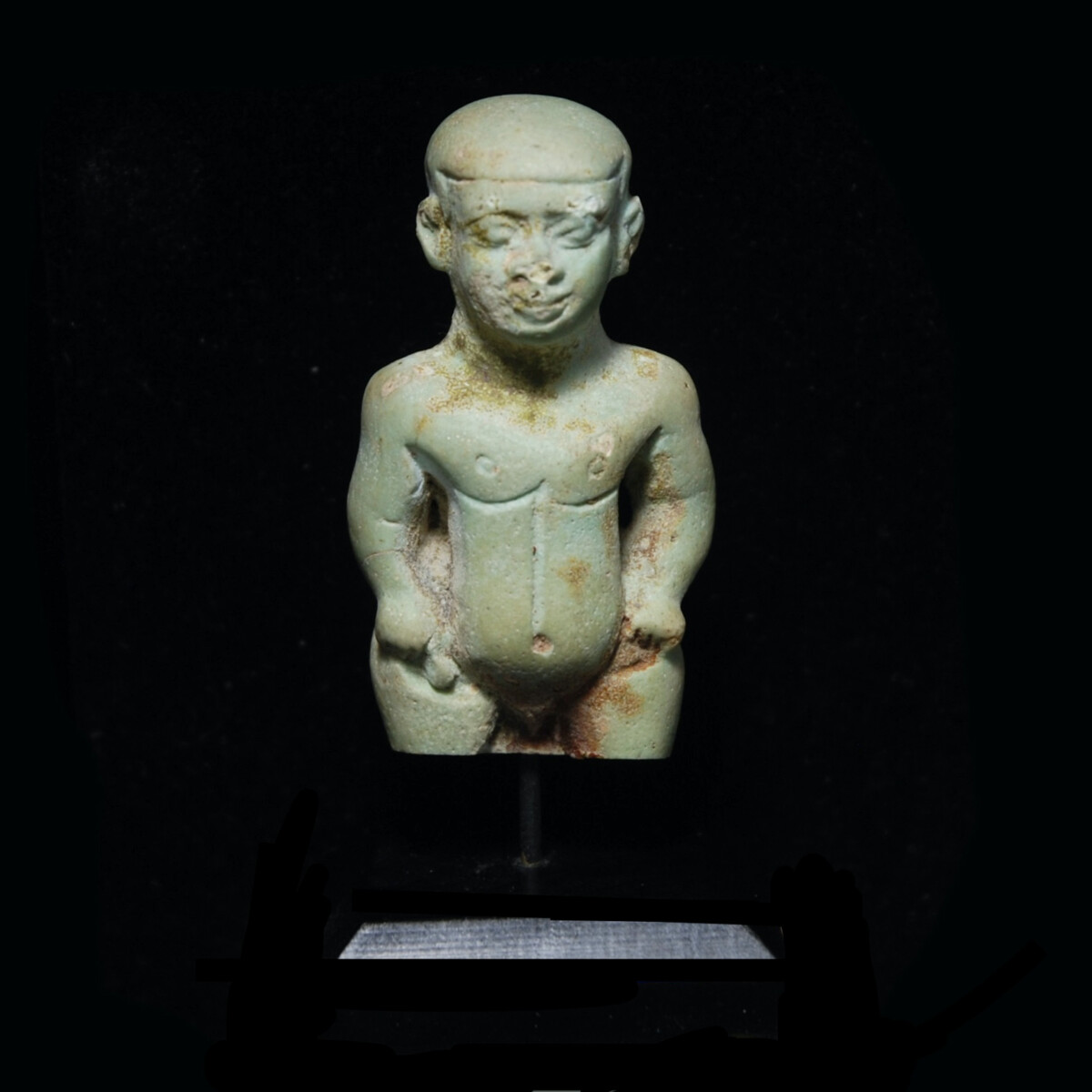
|
|
|
|
|
|
Egypt – Late period, 664-332 B.C.
|
A beautifully worked out, large amulet of a standing pataikos. The nude dwarf-god with an oversized head, which is flat on top and rounded at the back. The face with fine features, finely drawn brows and a friendly smile. The buttocks is far protruding at the back. The strong arms are formed to fists and pushed into the hips. On the back of the head a broad, multiple-ribbed eyelet for suspension reaching to the nape. Pataikos is a dwarf-like god who was very popular with the common people and had an apotropaic function. He is the naturalistic depiction of a dwarf and almost solely used as an amulet. Mounted.
|
Provenance: From the collection of Dr. J. T. Goodrich (1946-2020), New York.
Dimensions: 5.2 cm high
Price: 900 Euro
|
|
|
|
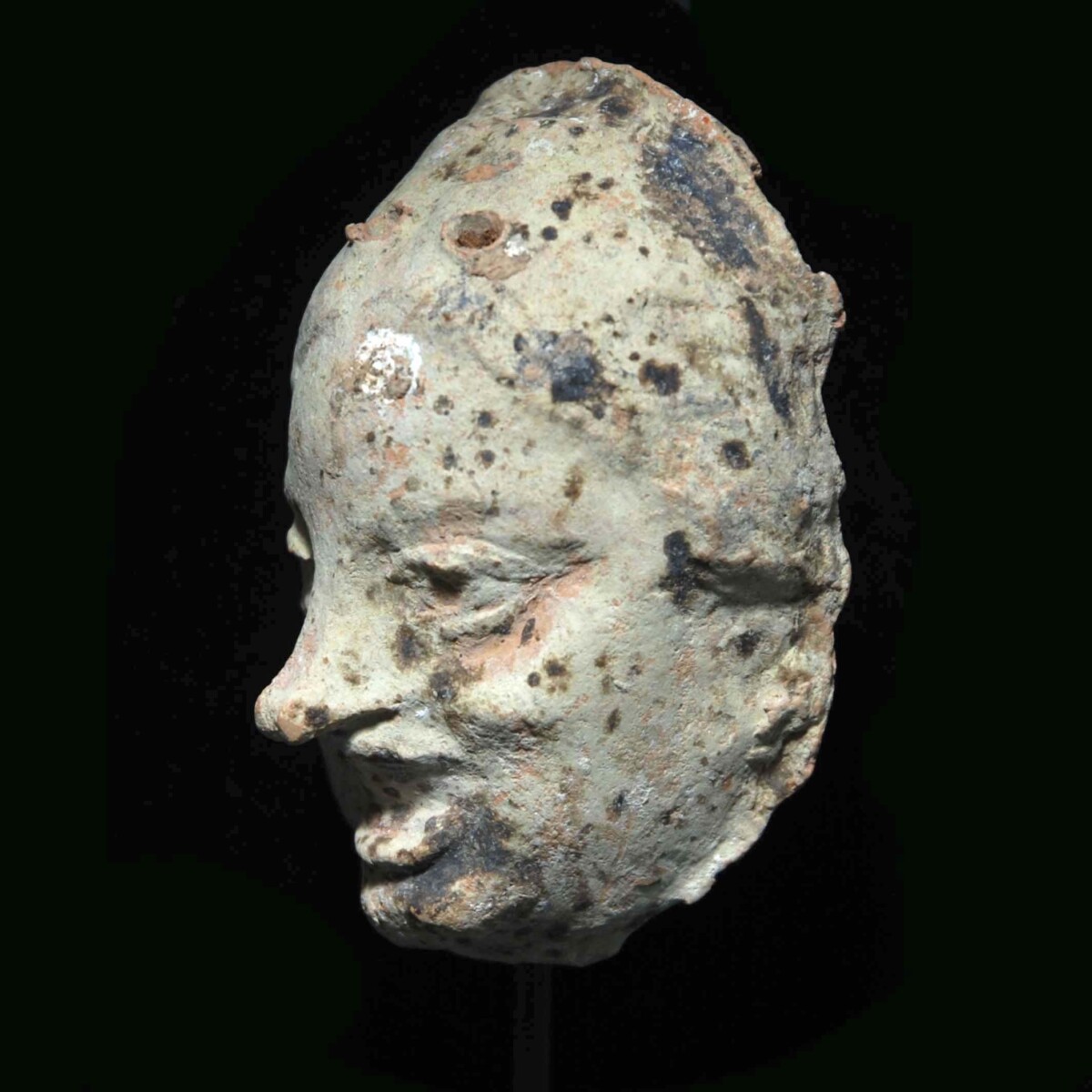
|
|
|
|
|
|
Greece – 5th century B.C.
|
Sculptural terracotta head protome or mask with prominent archaic features. The head, possibly a woman, with a long, pointy nose, wide open mouth and vigilant eyes between thick lids and above distinct cheekbones. The woman has her hair parted in the middle and wears a headdress. Above two holes for mounting. With remains of white engobe. Mounted.
|
Provenance: German private collection H. W., acquired from André de Munter in Brussels, Belgium.
Dimensions: 9.4 cm high
Price: 800 Euro
|
|
|
|
|
|
Griechen, Römer und die Königin von Saba
|
Es ist einer der großen Irrglauben unserer Zeit, zu meinen, alles was griechisch sei, stamme aus dem heutigen Griechenland, alles Römische aus Italien und alles Ägyptische aus Ägypten. Der Mittelmeerraum war in der Antike eine geschäftige, multiethnische Welt voller Bewegung und Austausch, die keine Hemmnisse nationaler Grenzen kannte. Ein wunderbares Beispiel dieser gegenseitigen kulturellen Bereicherung ist die monumentale Bronze-Statuette eines Gabenbringers. Der griechisch-römische Einfluss war seit dem 2. Jahrhundert vor Christus durch den Handel mit Kunstwerken auf die arabische Halbinsel gelangt. Die sabäische Elite nahm diese künstlerische Strömung mit Begeisterung auf, ahmte sie nach und verfeinerte sie durch lokale Anpassungen. Unser Jüngling trägt daher griechischen Haarschmuck, seine Kleidung ist jedoch orientalisch, sicher von den Persern inspiriert, und die klassische Haltung als Gabenbringer kennt man aus Zypern. Ein Kunstwerk voller Vielfalt, bereichert von den verschiedensten Kulturen der Antike.
|
|
|
|
Unser Highlight des Monats:
|
|
Südarabien – 2.-1. Jahrhundert v. Chr.
|
Große Bronze-Statue eines Gabenbringers aus dem südarabischen Königreich Saba in hellenistischer Zeit. Der junge Mann steht gerade mit unbekleidetem Oberkörper. Um die Hüfte hat er einen langen, gerippten Schurz gebunden, der ihm bis über die Knie reicht. Darunter trägt er Hosen, die die Knöchel bedecken. Er hat beide Arme abgewinkelt nach vorne gerichtet. In der linken Hand hält er einen kleinen Vogel, wohl einen Hahn. Die rechte ist zum Gebetsgestus angehoben. Der junge Mann hat kurzes Haar, das in breiten Strähnen in die Stirn fällt und von einem breiten Haarband gehalten wird. Die große Statue steht auf ihrer Original-Basis. Votivstatuen wie diese wurden etwa im Awwam-Tempel nahe Ma’rib im heutigen Jemen gefunden. Vergleiche zur Haartracht und zum Schurz die etwas ältere Statue in „Jemen – Kunst und Archäologie im Land der Königin von Saba“, Wilfried Seipel (Hrsg.), Nr. 253, Seite 327.
|
Provenienz: Privatsammlung Shlomo Moussaieff (1925-2015), Israel. Erworben zwischen 1948 und 2000.
Höhe: 33,5 cm
Price: 24.000 Euro
|
|
|
|
Ausgewählte Kunstwerke des Monats:
|
|
Ägypten – Spätzeit, 664-332 v. Chr.
|
Versenktes Relief aus Sandstein mit einer fein modellierten Darstellung des Nilgottes Hapi im Profil nach rechts. Hapi trägt eine dreiteilige Perücke mit einem langen Lappen, einen Götterbart, einen Halskragen und eine Krone mit einem Büschel Papyruspflanzen. Er streckt seinen linken Arm nach vorne und hielt darin wohl Papyrus- oder Lotusstengel. Hapi war verantwortlich für die Nilflut, die fruchtbaren Schlamm zurückließ und die von den Ägyptern „Ankunft des Hapi“ genannt wurde. Als Symbol des lebensspendenen Nils wurde er zudem als Schöpfergott und „Vater der Götter“ verehrt. Gesockelt.
|
Provenienz: Französische Privatsammlung Madame D. seit zumindest 45 Jahren. Zuletzt in einer gerichtlich angeordneten Versteigerung der Privatsammlung Madame D.
Dimensionen: 27 cm x 21,5 cm
Preis: 10.000 Euro
|
|
|
|
|
Römisches Reich/Lydien – 129 n. Chr.
|
Wunderbar erhaltene hochrechteckige Marmorstele aus Lydien in römischer Zeit. Der Stein mit zwölfzeiliger Inschrift wird oben von einem Giebel mit Akroteren bekrönt. Unmittelbar unter dem Giebel ist die Datierung nach der sullanischen Ära angegeben, die die Stele in das Jahr 129 n. Chr. datiert. Daran anschließend ein Blätterkranz. In der nun folgenden Inschrift ehrt ein gewisser Eirenios seine verstorbene Frau Tatia. Die Übersetzung lautet: „Eirenios ehrte Tatia, seine Frau und errichtete bei Leben und Verstand auch für sich dieses Grabmal. Und allen Verwandten zum Gedenken.“ Der Text ist also eine posthume Ehrinschrift. Vergleiche zum Typus einer Inschriftenstele mit Blätterkranz die Stele für Euarestos aus der Nekropole von Bin Tepe bei Sardis, ausgegraben von der Sardis Expedition mit der Inventarnummer NoEx80.001. Mit Gutachten und Übersetzung von der Wiener Epigraphikerin Mag. Katharina Michner BA MA. Gesockelt.
|
Provenienz: Deutsche Privatsammlung H. W., Nordrhein-Westfalen, erworben vor 1980.
Dimensionen: 67 cm x 28 cm
Preis: 16.000 Euro
|
|
|
|
|
Griechenland/Böotien – 6. Jahrhundert v. Chr.
|
Großes, handgeformtes Brettidol mit flachem Körper, der nach unten zu einem ovalen Standring ausschwingt und nach oben in einen plastischen Kopf mit aus der Matrize geformtem Gesicht übergeht. Das Gesicht mit archaischen Zügen, großen, schwarz umrandeten Augen, roten Backen und einem breit lächelnden, rot gefärbten Mund. Lange, schwarz aufgemalte Haare fallen seitlich bis auf die Schultern herab. Die Göttin trägt einen hohen, schalenförmigen Polos, der auf der Vorderseite eine halbrunde, schnabelförmige Ausbuchtung aufweist. Die kurzen Arme sind seitlich weggestreckt und leicht nach vorne gebogen. Auf der gesamten Vorderseite des Körpers reich erhaltene Bemalung aus roten und schwarzen Linien. Auf der Brust ein rot schraffiertes Feld. Rote Bänder um den Hals stehen für Schmuck. Idole wie dieses stellen vermutlich Göttinnen (Demeter, Hera?) dar. Sie werden aufgrund des Kopfschmucks auch als Papades bezeichnet. Gesockelt.
|
Provenienz: Aus der alten deutschen Sammlung Christian Rolle, dort mit der Registernummer 166 inventarisiert. Danach Antikenkabinett Gackstätter mit der Listennummer 0991. Mit Original-Zertifikat des Antikenkabinetts Gackstätter. Zuletzt in einer Münchner Sammlung von antiken Idolen.
Höhe: 25,6 cm
Preis: 4.800 Euro
|
|
|
|
|
Mespotamien – 3500-3000 v. Chr.
|
Massives, glockenförmiges Augenidol aus Alabaster. Der zylindrische Körper steht auf einem glatten Boden. Die Schulter abgerundet und in das brillenähnlich ausgearbeitete Augenpaar übergehend. Die Augen sind kreisrund durchbohrt. Im Halsbereich betont eine Einkerbung die Kreisform, was die Wirkung des Augenpaares verstärkt. Idole wie dieses wurden nicht im berühmten Augentempel von Tell Brak, sondern an anderen Orten in Nordmesopotamien gefunden. Dieses Exemplar soll aus Tappa Gaura, einem Siedlungshügel im heutigen Irak stammen.
|
Provenienz: Aus der alten deutschen Sammlung Professor Göring, vor 1980. Danach bei Antikenkabinett Gackstätter mit der Listennummer 01737. Zuletzt in einer Münchner Sammlung. Mit dem Original-Zertifikat des Antikenkabinetts Gackstätter.
Höhe: 7 cm
Preis: 4.800 Euro
|
|
|
|
|
Eurasische Steppe – 8.-6. Jahrhundert v. Chr.
|
Besonders expressiv gestaltetes ithyphallisches Idol der eurasischen Steppenvölker. Der aufrecht stehende, stark stilisierte Mann ist unbekleidet, hat die Beine leicht gespreizt und die Hände auf seinen Bauch gelegt. Der flache, fast gepresst wirkende Oberkörper ist leicht nach hinten geneigt, den erigierten Phallus zur Schau stellend. Der überprotionale, kahle Kopf mit seinem maskenartigen Gesicht ist vollplastisch ausmodelliert. Er wird von der halbrunden, spitzen Nase und den herausquellenden Augen dominiert. Der schmale Mund ist tief gekerbt. Die Beine sind akzentuiert und leicht eingeknickt. Rückseitig setzt am kräftigen Hals die tiefe Kerbe der Wirbelsäule an, die bis über das Gesäß reicht. Eine seltene, höchst ausdrucksstarke Statuette. Gesockelt.
|
Provenienz: Aus der alten deutschen Sammlung Prof. Levkovic. Danach bei Antikenkabinett Gackstätter mit der Listennummer 02970. Zuletzt in einer Münchner Sammlung von Idolen. Mit dem Original-Zertifikat des Antikenkabinetts Gackstätter.
Höhe: 6,8 cm
Preis: 3.200 Euro
|
|
|
|
|
Griechenland – 6.-5. Jahrhundert v. Chr.
|
Opakes, blaues Glas mit kugelförmigem Korpus, kurzem Hals und trichterförmigem Rand. Gelbe und weiße Zierfäden sind an der Schulter und im unteren Bereich des Korpus gerade aufgespult, dazwischen mehrere Reihen wellenförmiger eingelegter Zierbänder. Die auf der Schulter aufgesetzten Henkel sind separat gearbeitet und angesetzt und werden aufgrund ihrer geschwungenen Form als Delphin-Ösenhenkel bezeichnet. Am Rand ein gelber Glasfaden. Durch seine dicke Irisierung hat dieser Aryballos eine wunderbar in Perlmutt schimmernde Oberfläche. Die um einen Kern geformten und einst mit kostbaren Essenzen gefüllten Aryballoi wurden in Ständer gesetzt. Sie wurden im östlichen Mittelmeerraum zusammen mit Ständern aus Glas und Gold gefunden. Mit Standring. Mit altem Sammungsetikett mit der Nummer 83. Gesockelt.
|
Provenienz: Aus der Privatsammlung des französischen Archäologen Louis-Gabriel Bellon (1819-1899). Seit über 120 Jahren in Familienbesitz.
Höhe: 6,5 cm
Preis: 4.600 Euro
|
|
|
|
|
Ägypten – Neues Reich, 17.-19. Dynastie, etwa 1550-1185 v. Chr.
|
Prachtvolle, neu gefädelte Halskette mit 27 Mohnblüten-Amuletten in Rot, Weiß, Blau und Grün aus Karneol und Glas. Dazwischen kleine Karneolperlen. Die Mohnblüten-Amulette mit breiten Blütenkörbchen und durchbohrtem Stiel zur Aufhängung. Mohnblumen wurden seit dem Neuen Reich als Regenerationssymbole auf Ketten wie in diesem Fall oder einzeln als Amulett getragen.
|
Provenienz: Aus alter französischer Privatsammlung M. N., erworben in den 1960er Jahren.
Länge: 53 cm
Preis: 8.000 Euro
|
|
|
|
|
Ägypten – Spätzeit, 664-332 v. Chr.
|
Nur fragmentarisch erhaltene und dennoch ausdrucksstarke Bronze-Statuette des ithyphallischen Fruchtbarkeitsgottes Min. Min trägt einen reichen, mehrlagigen Halsschmuck, der vorne und hinten gleich opulent ist. Vom hinteren Ende des Halsschmucks verläuft ein vertikales Band Schmuckband seinen Rücken hinab. Mit der linken Hand hält er sein erigiertes Glied, der rechte Arm ist angehoben und abgewinkelt, in der Hand hielt Min eine Geißel als Zeichen der Zeugungskraft. Die tief gelochten Augen trugen einst Einlagen aus Silber. Am Kopf sitzt eine Krone mit einer tiefen Lochung, in der ein hohes Federnpaar steckte, das ebenfalls fehlt. Die Figur war einst von besonderer Qualität, sämtliche Attribute waren wohl separat gefertigt. Aufgrund der expliziten Darstellung fielen Min-Statuetten besonders häufig den frühchristlichen Devastierungen zum Opfer. So auch diese Statuette, deren Beschädigungen in die Antike zurückreichen. Vergleiche zum Typus die Statuette im Louvre Paris mit der Inventarnummer E 4073. Gesockelt.
|
Provenienz: Sammlung Gustav Schütz, Wien. Erworben zwischen 1920 und 1935. Danach weiterhin im Besitz der Familie. Mit handschriftlicher Provenienzbestätigung der Erbin.
Höhe: 10,6 cm
Preis: 2.200 Euro
|
|
|
|
|
Römisches Reich – 2. Jahrhundert n. Chr.
|
Fein gearbeitete Bronze-Statuette eines unbekleideten Mannes mit nubischen Gesichtszügen. Er steht mit dem Gewicht auf seinem rechten Bein und hat das linke leicht abgewinkelt und nach außen gedreht. Die rechte Hand und der linke Ellbogen sind auf einen langen knorrigen Stab gestützt. Die linke Hand stützt den Kopf. Die Figur steht noch auf seinem treppenförmigen Original-Podest. Der Kopf ist oben etwas abgeflacht, was darauf hindeutet, dass die Statuette als Stütze, möglicherweise für ein Möbel diente.
|
Provenienz: Deutsche Sammlung P. R. seit den frühen 1980er Jahren.
Höhe: 8 cm
Preis: 900 Euro
|
|
|
|
|
Ägypten – Spätzeit, 664-332 v. Chr.
|
Schön gearbeitetes, großes Amulett eines stehenden Patäken. Der nackte Zwergengott mit übergroßem, oben flachem und hinten abgerundetem Kopf. Das Gesicht mit feinen Zügen, zart gezogenen Brauen und einem freundlichen Lächeln. Das kräftige Gesäß hinten weit ausladend. Die kräftigen Arme sind zur Faust geballt in die Hüfte gestemmt. Am Hinterkopf setzt eine breite, mehrfach gerippte Öse zur Aufhängung an, die bis in den Nacken reicht. Der Patäke ist ein zwergwüchsiger Gott, der im Volk sehr beliebt war und apotropäische Funktion hatte. Er ist die naturgetreue Wiedergabe eines zwergwüchsigen Menschen und fast ausschließlich in Amulettform belegt. Gesockelt.
|
Provenienz: Aus der Sammlung Dr. J. T. Goodrich (1946-2020), New York.
Höhe: 5,2 cm
Preis: 900 Euro
|
|
|
|
|
Griechenland – 5. Jahrhundert v. Chr.
|
Plastische Terrakotta-Kopfprotome oder -maske mit ausgeprägten archaischen Zügen. Der Kopf, wohl einer Frau, mit langer spitzer Nase, weit geöffnetem Mund und wachen Augen zwischen dicken Lidern und über ausgeprägten Backenknochen. Die Frau trägt das Haar in der Mitte gescheitelt und Kopfschmuck. Oben zwei Löcher zur Befestigung. Mit den Resten weißer Engobe. Gesockelt.
|
Provenienz: Deutsche Privatsammlung H. W., erworben bei André de Munter in Brüssel.
Höhe: 9,4 cm
Preis: 800 Euro
|
|
|
|
|
|
|
CHRISTOPH BACHER ARCHÄOLOGIE ANCIENT ART GmbH
|
Galerie: Stubenring 20, A-1010 Wien
Showroom: Untere Viaduktgasse 55, A-1030 Wien
|
|
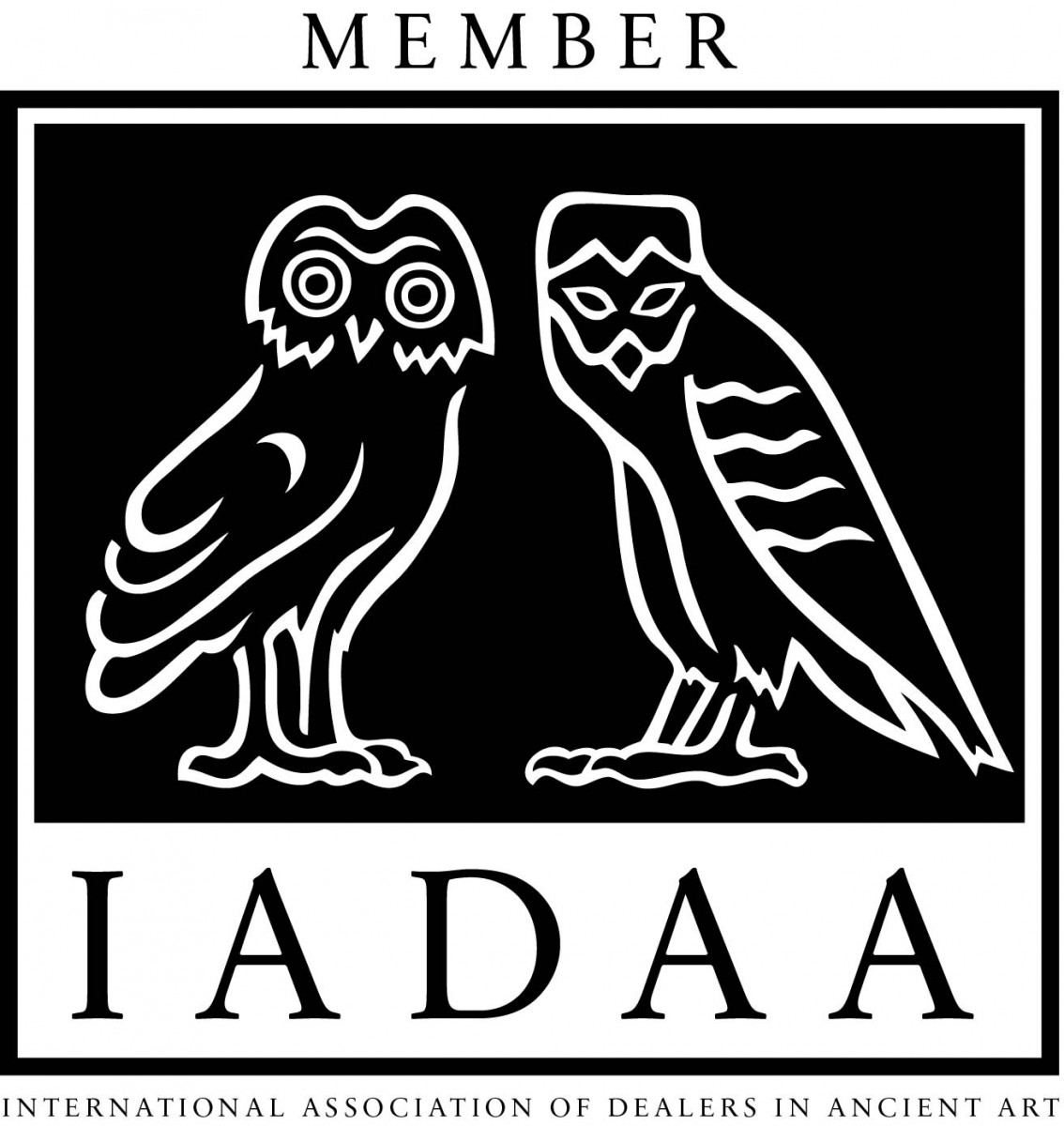
|
|
|
|